In the first part of this review, I discussed the outward appearance of four similar pocket sketchbooks, the Moleskine, the Pen & Ink Journal, the HandBook, and the Derwent Journal. Now I’ll look at the insides. Rather than bore you with repeated photos of almost identical things, I’ll just point out a few details that make each notebook distinctive.
The Pen & Ink sketchbook can be opened quite far, though unfortunately I did split the last signature from the binding a little by doing this– oops! None of the other notebooks would open this far:
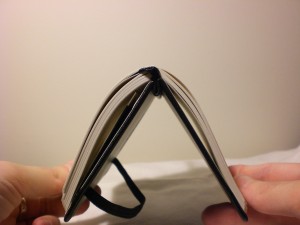
The inside front cover of the Derwent is totally plain, and offers a nice extra pocket where you could stash a few receipts or business cards.
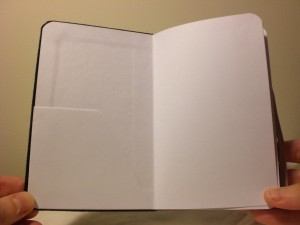
The Derwent has a very wide-opening back pocket, inside of which there is a sticker, seemingly indicating the date the notebook was made. (Maybe it will go bad if I don’t use it by a certain date…)
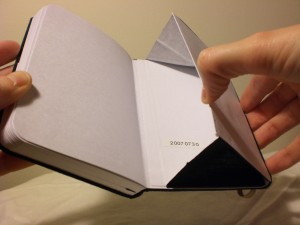
Here’s the inside front cover of the HandBook journal: a shaded box where you can write your info if desired, and the address of the manufacturer. Unlike other notebooks, they intend you to write your details on the inside front cover, not the facing page.
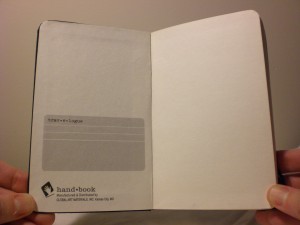
The HandBook journal can be opened quite wide, but the way the spine sticks out doesn’t exactly qualify it as “lay flat.” Unlike most other notebooks, the pocket in the back is made of clear plastic, with a flap on the opening, which faces the outside. This is quite nice for stashing things you might actually want to look at: in the HandBook I used on my safari trip, I saved a beautiful leaf as well as some ticket stubs in the pocket.
The shots below give you an idea of the paper color of each notebook as well as showing how some different pens, pencils and watercolor performed. The Pen & Ink and Moleskine notebooks have creamier looking paper. The HandBook paper is a somewhat cooler white, while the Derwent is a VERY cool white– it’s almost unpleasant, kind of like the difference between some of those compact fluorescent bulbs and regular incandescent light!
Most of these papers are too smooth for soft charcoal, except the somewhat rougher HandBook. All work well with rollerball pens– even the HandBook went fairly smoothly. All took watercolor nicely too– this surprised me a bit as in past Moleskines I sometimes found that watercolor could bead up a bit. Unfortunately I don’t have a good macro lens, so you won’t quite be able to see that none of the rollerball inks got feathery in any of these notebooks except the Uniball Vision Micro, which performed slightly better in the Moleskine & Pen & Ink journals than in the others.
Pens used, top to bottom:
- Super Sharpie
- Uniball Vision Micro
- Pigma Brush Pen
- Ballpoint
- Uniball Signo 207 Micro
- Uniball Signo RT 0.38
- 2H pencil
- Soft charcoal pencil
- Watercolor paint
Since all of these notebooks have thicker paper than a standard Moleskine, they tend not to let inks show through too much. The Derwent (upper right) scored best in this respect:
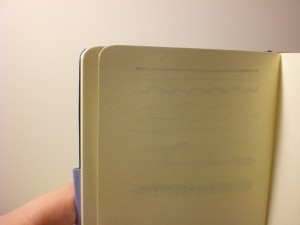
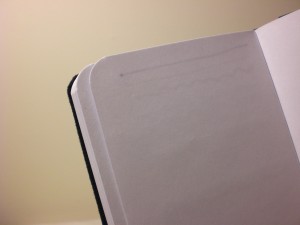

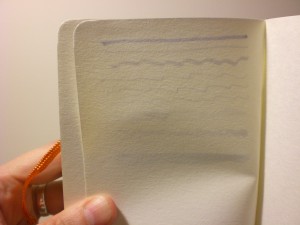
The lighting isn’t exactly equivalent in each photo (I try to be scientific, but I’m not Consumer Reports here, folks!). However, when the pages are held flat with no backlighting, the Derwent shows nothing at all on the other side except for the Sharpie.
So which notebook wins on its interior factors? Again, it all comes down to personal preference. The Derwent has the nice little extra pocket and its back pocket is easier to get into with its wide opening. It also has very smooth paper that won’t show bleed-through from most pens. But if you’re used to the color of Moleskine paper, you might find the Derwent’s deathly pallor a bit unnerving.
The HandBook will please artists who like to use pencil due to its slightly more textured paper, and the clear plastic pocket can be handy.
The Pen & Ink journal and the Moleskine are almost identical on the inside. The only real difference is that the Pen & Ink’s inside front cover is totally plain– no lines for info or a reward amount, no company address, no nothing.
Stay tuned for one final installment in this multi-part review, where I’ll cover bang for the buck, where to buy, and wrap up the pros and cons.

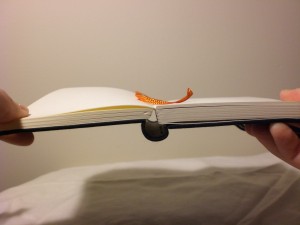


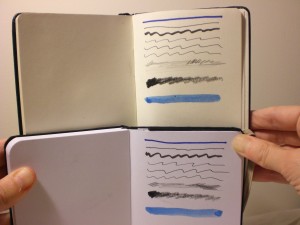
Great review!
Thanks for the link! Looking forward to the next installment.
What’s up to every one, it’s actually a pleasant for me to
go to see this web site, it includes useful Information.
Just wanted to say a big thank you for doing this blog on journals. It is enormously helpful, and saved me a lot of money on buying these to find out. I love journals, and finding the right variables is very hard work indeed! Again… thank you! :)